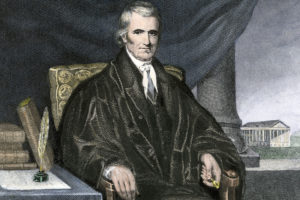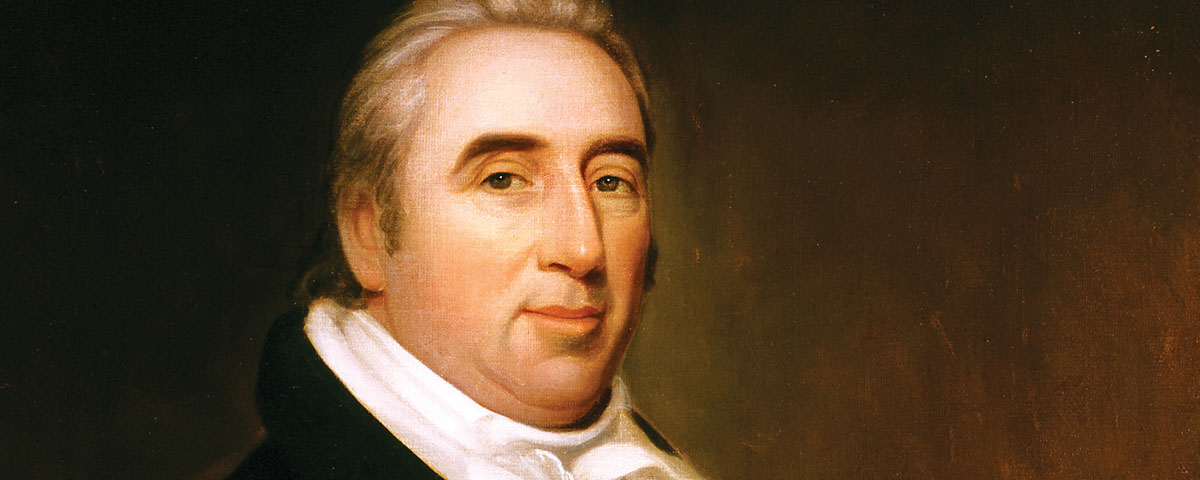The U.S. Supreme Court—unlike the highest courts in 10 American states and in many foreign countries—cannot rule on abstract questions of law, only on actual controversies between actual litigants. Often those litigants represent thousands, even millions, in similar circumstances—children attending racially segregated schools, or same-sex couples who want to marry. But in the first case of continuing importance that the Court decided, the ruling came on a problem affecting four persons. And in the greater scheme the problem wasn’t even very consequential.
Nonetheless, the 1803 decision in Marbury v. Madison arguably matters as much as any the tribunal has handed down. Marbury set out the very way this country’s legal system works and through legal legerdemain avoided a potentially perilous conflict.
The case arose from the nation’s attempts to deal with political parties. From the start, American leaders differed over whether the country should be mainly agrarian, focusing power in state governments’ hands, or have a strong, industry-fostering central government. But no organized groups took up those views; in fact, at the end of his presidency, George Washington was warning Americans against “the baneful effects of the Spirit of Party.”
Under John Adams, distinct parties did emerge. A Federalist ticket Adams headed in his 1800 reelection bid got 65 electoral votes, losing to a slate led by Thomas Jefferson with 73. Taking the House of Representatives, Jefferson’s party put him in the White House.
With Jefferson to take the oath of office on March 4, 1801, Adams’s party rushed to consolidate power. Last-minute patronage legislation authorized the president to name new justices of the peace for the District of Columbia. On March 3 Adams signed 23 such commissions for Washington County on the Maryland side of the Potomac River and 19 for Alexandria County in Virginia. All 42 were hurried to Secretary of State John Marshall so he could attach the Great Seal of the United States and deliver each appointee his commission; 25 commissions got delivered in time.
Of the other appointees, 13 cared little that their commissions did not arrive: they were prominent citizens for whom becoming a justice of the peace was no big prize. The remaining four—William Marbury, Dennis Ramsay, Robert Townsend Hooe, and William Harper—did care, obstinately. Their intransigence was at the crux of Marbury v. Madison.
Those four were prominent, too. Marbury was a top aide to the Secretary of the Navy. Ramsay had been so trusted a Washington lieutenant that he had been a pallbearer at the former president’s funeral. Hooe had been mayor of Alexandria, Virginia; Harper was an Alexandria alderman—and a big landowner there. Still, they wanted those appointments.

The four asked James Madison, Marshall’s successor as secretary of state, to deliver their commissions. Madison, at Jefferson’s order, refused. Marbury and cohort went to the Supreme Court, petitioning the justices to issue an order—officially, a “writ of mandamus”—compelling Madison to hand over the commissions.
If issued and resisted, as seemed possible, that writ could have caused a constitutional crisis. Intense personal animosity separated Jefferson and Marshall, who in the Adams administration’s final days had been named chief justice. The Jefferson administration did not bother to appear before the justices to argue its case. Clearly, the Court would have no way to force Madison to obey any writ the Court might issue.
Yet the justices felt compelled to acknowledge the legitimacy of claims by Marbury, Ramsay, Hooe, and Harper to commissions the president had signed and the secretary of state had recorded. Marshall found a way to finesse the dilemma. In the opinion he wrote for the unanimous four-justice panel, the chief justice acknowledged the four litigants’ right to the writs they requested and that Congress, in the Judiciary Act of 1789, specifically had authorized the justices issue such writs.
Even so, Marshall said, the justices had no such power. The 1789 provision conveying that authority was unconstitutional because it reached beyond what Article Three—which defines the judiciary’s role—allowed, Marshall said. His reasoning displayed audacity. True, the Constitution did not specifically authorize federal courts to issue writs of mandamus—but neither did the Constitution empower those courts to declare acts of Congress unconstitutional.
Yet authority to do so had to reside somewhere. It was one thing to form a government bound by a written Constitution outlining exactly what the executive and the legislature could do and—after adoption of the Bill of Rights in December 1791—what those branches could not do. But of what use would such limits be without a way to enforce them, of saying a president or a Congress had gone too far?
The men drafting the Constitution recognized that dilemma but in the final document did not address it—probably because they assumed such powers to accrue inherently to the courts. Without specific authority from state constitutions, courts in most states had been declaring state laws unconstitutional. For instance, in 1780 New Jersey’s highest court struck down a law allowing six-man juries, and in 1785 the Connecticut Supreme Court declared unconstitutional a law altering the terms of a colonial land grant.
Marshall’s opinion reasoned that, in asserting the power to hold an act of Congress unconstitutional, the justices simply were doing the job assigned them. “If both the law and the constitution apply to a particular case…the court must decide which of these conflicting rules governs the case: this is the very essence of judicial duty,” he wrote.
But the framers already had stated that the Constitution had supremacy. Alexander Hamilton made that abundantly clear in The Federalist Papers, issued to explain the Constitution to the populace. “It is a proposition too plain to be contested, that the constitution controls any legislative act repugnant to it,” Hamilton wrote. It logically follows that contrary actions by Congress must be deemed invalid.
The beauty of Marshall’s ruling is that the decision established the federal judiciary’s power to review executive and legislative action while, notes Georgetown University law professor Susan Low Bloch, “ordering no one to do anything, and thus providing no opportunity for defiance or resistance. It was a remarkable feat.”
Federal courts’ authority to oversee the other branches of government is accepted broadly. “At no time in our history has the power of judicial review been seriously endangered,” a popular constitutional law textbook explains. “Despite attacks on the Court’s decisions, on its personnel, and even on the procedures by which review is exercised, no major political party has ever urged the complete abolition of the power of review itself.”
That record came to be largely because the Court has been cautious in exercising its review power. Having established their authority in Marbury, justices went more than 50 years before again declaring a statute unconstitutional—an 1857 ruling, in the case of a slave, Dred Scott, that Congress had no power to bar slavery in the territories.





